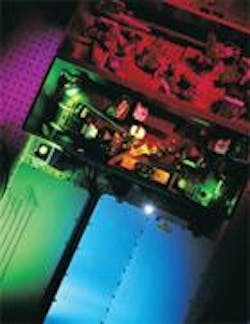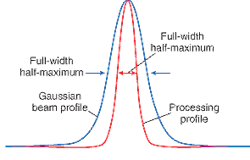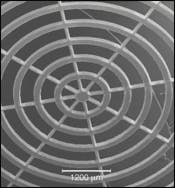Ultrafast technology delivers OEM lasers
By Philippe Feru and Alan Fry
The first applications for any new class of laser are usually as tools in scientific research. Industrial applications do not develop until there are robust lasers available from original equipment manufacturers (OEMs) that feature reliable, "hands-free" operation. Ultrafast laser technology has recently reached this milestone, and is poised to have an impact on several important industrial applications.
Materials processing with ultrafast pulses
Most of the emerging industrial applications for femtosecond lasers fall under the category of direct write, precision materials processing, in which the focused laser beam is used to create microscopic cuts, holes, grooves, or surface features by selectively removing material. Successful processing requires the creation of these small features without thermal damage to surrounding material or underlying layersthe heat-affected zone (HAZ). Ultrafast lasers can meet this requirement better than any other type of laser. In addition to offering direct-write process flexibility, ultrafast lasers can also process a wider range of materials than other lasers, potentially bringing the benefits of laser materials processing to a very wide applications base.
These benefits arise because in precision materials processing it is desirable to minimize peripheral thermal shock and damage. Poorly executed thermal laser drilling of ceramics, for example, can result in the production of a brittle glassy phase in the surrounding material. When an ultrafast laser is focused onto a work surface, the high peak power drives multiphoton absorption, directly breaking all the bonds and atomizing the material. Hence, the amount of generated heat is so small that it is dissipated before the arrival of the next pulse. This atomization process is referred to as cold ablation and allows ultrafast lasers to precisely process even delicate or highly sensitive materials such as ultrathin films and high explosives. It also allows the creation of holes without damage to any materials or structures behind the holeso-called "backwall protection."
Ultrafast lasers are also capable of very high spatial resolution, another factor critical for direct-write processing. This high resolution results from the TEM00 output of the regenerative amplifiers, which can be focused to a near diffraction-limited spot on the work surface. Furthermore, the 800-nm output leads to a much smaller diffraction limit than mid-infrared lasers. The ultrafast output can be efficiently converted to visible (400 nm) and ultraviolet (266 nm) wavelengths because of the high peak power, resulting in an even smaller spot size. Because the primary ablation process has a highly nonlinear dependence on laser power density, the processing cross section of the laser beam is much narrower than the Gaussian beam width, which can result in processing resolution even below the diffraction limit (see Fig 1).
Ultrafast lasers can process a broad range of materials, including those that are transparent to the incident wavelength of the laser because the ultrafast pulses machine by driving nonlinear multiphoton absorption with high peak fluences, so strong absorption at the workpiece is not critical.
With this combination of benefits, ultrafast lasers can improve the outcome of existing materials processing applications, as well as opening up new applications that are not possible with traditional lasers. For instance, ultrafast pulses can produce shaped holes with very smooth walls in "difficult" materials such as ceramics and stainless steel (see Fig 2). Specific applications include creating the holes for fuel injector nozzles and in inkjet printer heads. Ultrafast pulses are also used in semiconductor failure analysisthey can precisely remove material and expose the transistor layer in a die. Another important application is photomask repair for microlithography, in which ultrafast lasers deliver a precision that would be impossible to achieve with other technologies (see "Femtosecond lasers repair photomasks," p. 77). Ultrafast lasers are also able to produce tiny medical devices such as the stents used in angioplasty procedures.
Ti:sapphire oscillator/amplifier systems
Although modelocked ultrafast lasers have been around since the 1970s, most of the key commercial developments in ultrafast lasers have taken place within the past decade. These developments are a direct result of the superior material properties of the Ti:sapphire crystal, which is now the de facto standard as an ultrafast gain medium.
Early modelocked Ti:sapphire lasers were optically complex and were pumped by water-cooled argon ion lasers. To achieve high energy (>1 mJ) pulses, regenerative amplifiers were required to amplify the output of Ti:sapphire laser. With regenerative amplification, the repetition rate, power, and reliability of the amplifier is largely dictated by the pulsed laser used to pump the amplifier's Ti:sapphire crystal. Initially, these pulsed pump lasers were frequency- doubled, flashlamp-based Nd:YAG lasers emitting at 532 nm.
The next important step forward was the advent of diode-pumped Nd:YVO4 (vanadate) lasers. These all-solid-state devices provide several watts of high-reliability, low-noise, continuous-wave (CW) output at 532 nm and are ideal for pumping a Ti:Sapphire oscillator. These developments led to the first all-solid-state ultrafast laser oscillator systems. At the same time, laser manufacturers made significant advances in high-power, diode-pumped, intracavity-doubled lasers delivering high energy Q-switched pulsesoutput characteristics that are well-suited to pumping Ti:sapphire regenerative amplifiers. The medium of choice in these lasers is Nd:YLF because of its long upper-state lifetime, low thermal lensing, and natural birefringenceit delivers high energy per pulse and high average power at a 1-kHz repetition rate.
With the availability of solid-state pump lasers for both the ultrafast oscillator and the regenerative amplifier, it became possible to build a completely solid-state system providing high-energy amplified pulses of around 100 fs.
Together, these advances led to natural product integration and the advent of the "one box" ultrafast laser. The small size, low power consumption and solid-state reliability allowed both the pump laser and the Ti:Sapphire oscillator to be combined on a single platform, resulting in a single integrated laser head. Several manufacturers then took this concept to its logical conclusion by developing user-friendly, one-box ultrafast amplifiers. In these, the single-box oscillator is combined with a regenerative amplifier and its solid-state pump laser to deliver amplified ultrafast pulses from a single, small package.
Defining OEM requirements
The single-box amplifiers were readily accepted by scientists in many disciplines, resulting in a wider range of ultrafast researchfrom production of terahertz pulses (see p. 133) to studies in solvation dynamics. Several industrial research groups and systems integrators also began to investigate the potential of ultrafast pulses in industrial applicationsmainly in precision materials processing. While the benefits of ultrafast pulses were obvious in these pilot studies, it became clear that several practical aspects would have to be addressed before ultrafast technology would penetrate real-world applications.
A survey of potential industrial users of these one-box lasers indicated that the most important consideration is user-friendly "hands-free" operation. Economics dictates that a semiskilled operator, rather than a highly paid laser expert, must operate a materials processing workstation. Furthermore, the high cost of down time in industrial applications means the laser also must be extremely reliable, requiring the absolute minimum in scheduled maintenance. Finally, integration of the laser into the final system must be seamless. Straightforward integration means not only a small footprint and a simple computer interface (such as RS-232), but also a highly stable optical interfacemeaning stable beam output power, beam quality, and beam pointing. Such stability eliminates the complexity of subsequent active compensation for changes in the laser output.
Potential users also specified a need for laser self-diagnosisa trend now common in industrial lasers of all types. The quality of work produced in a materials processing application is critically dependent on the quality of the laser output. Previously, a problem with the laser-beam mode, shape, or power might not become apparent until final testing of the product. Extensive on-board laser diagnostics, however, can alert the user immediately to beam problems that the computer cannot correct. On-board diagnostics are even more important in ultrafast lasers, in which a full suite of external diagnostics may otherwise require specialized tools and a knowledgeable operator.
Meeting OEM requirements
To meet all these requirements, we developed a new generation of rugged OEM one-box amplifiers capitalizing on recent advances in laser-diode technology and the latest laser manufacturing methods and practices (see photo, p. 77).
These systems are based on a modular design with three main modules: one-box oscillator, amplifier, and amplifier pump laser. The modular design means that if a problem occurs within one module, it can be addressed without disturbing the others. Each module is sealed within its own isolated environment that is automatically maintained at an optimum temperature. The modules are designed for continuous operation with no external adjustment. All the optical components are fixed in rigid mounts that are attached to a monolithic platform, which eliminates the effects of external vibration or thermal drift. The more sensitive components are further stabilized by automated beam-alignment systems that actively maintain optical alignment. Amplifier performance is, therefore, always optimized and the beam pointing direction remains fixed. This approach provides hands-off operation, eliminating the need for end users to tweak the optics.
The fundamental components of the system, common to all solid-state lasers are the pump diodes. Recent advances in laser-diode technology, in terms of both output power and reliability, mean that typical lifetimes now exceed 10,000 hours. Moreover, by fiber coupling the diodes, which are mounted in the laser power supply, eventual diode replacement is simple and requires no realignment of any optics. Both factors combine to deliver the reliability and ease of maintenance demanded by OEM integrators and end users.
PHILIPPE FERU is a product manager at Spectra-Physics, Mountain View, CA, and ALAN FRY is project manager at Positive Light, Los Gatos, CA; e-mail: [email protected].
Femtosecond lasers repair photomasks
Chromium-on-fused-silica photomasks for deep-ultraviolet (typically 248- or 193-nm) photolithography are expensive to fabricate and difficult or even in some cases impossible to manufacture free of defects. Typical defects include excess absorber in undesirable places; their removal must result in high light transmission without damage to the underlying fused silica or adjacent areas. Such strict requirements have rendered earlier repair methods with nanosecond lasers or focused ion beams inadequate.
If laser pulses of sufficiently short duration (typically ~100 fs) are used to ablate absorber materials on photomasks, the excess absorbing material is converted directly into a plasma with essentially no heat generation. The spatial resolution can be exceptionally high, even below the diffraction limit, and this is essential for repairing the submicron features on photomasks. In addition, the threshold for ablation of the absorber is lower than for the glass, permitting complete removal of the metal without substrate damage.1, 2
Femtosecond lasers are well suited to repairing photomasks. We have constructed two ultrafast laser-based photomask repair tools now operating at IBM's Burlington, VT, mask-making facility.3, 4 These tools are among the first applications of femtosecond technology in a semiconductor manufacturing environment. Our first tool imaged and ablated at 400 nm. A second-generation tool images at 248 nm and ablates at 266 nm. A defect is located, outlined in software, and removed by scanning the focused laser pulses over the identified region. In this manner a defect of any shape or size can be removed.
Operating at deep ultraviolet wavelengths provides exceptional resolution both in defect imaging as well as in the repair process itself. We have ablated lines below 100 nm in width in the chromium absorber. Such resolution facilitates repairs in tight lines and spaces and also results in high edge-placement accuracy, which is critically important for good chip performance. In a transmitted 248-nm optical micrograph of a Cr-on-glass photomask, the dark areas are chromium covered and the light regions are bare fused silica (see figure). The lines are 0.75 μm in width. Two regions in the "before" image (left) are in need of repairthe excess chromium between the reversed "L" shape and the vertical line, and a second region between the elongated, reversed "L" and the "T." The repaired regions are seen in the "after" micrograph (right). The entire process is carried out in air. No debris or glass damage is seen after the repair.
Our most recent femtosecond laser photomask repair system operates continuously and is the prime tool used to repair photomasks in manufacturing.
Richard Haight, Peter Longo, and Alfred Wagner
IBM TJ Watson Research Center
PO Box 218
Yorktown Heights, NY
REFERENCES
1. P. P. Pronko et al., Appl. Phys. Lett. 78, 6233 (1995).
2. B. C. Stuart et al., PRL (what is PRL?) 74, 2248 (1995).
3. R. Haight et al., SPIE 3546, 477 (1998).
4. R. Haight et al., Vac. Sci. Technol. B17(6), 3137 (1999).




